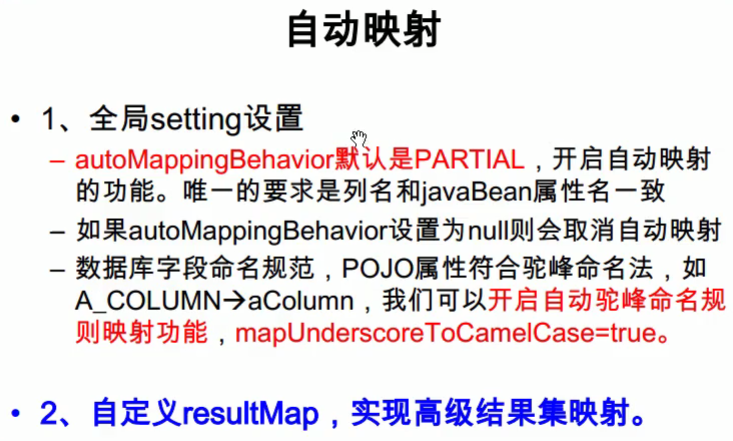1、select还有以下属性:

2、自动映射

3、使用resultMap
mybatis-conf.xml配置文件中,需要把settings标签放在properties之后,environments之前,不然会报错。由于数据库字段last_name和java属性lastName不匹配。有三种解决方式,一种是在查询的时候取别名,第二种是配置驼峰命名法,配置之后会自动将数据库中的带有下划线的字段映射为lastName。第三种是自己利用resultMap自定义结果返回集,在其中进行映射。
在一般情况下,我们使用resultType作为标识返回值,例如:
在EmployeeMapper.java中
public Employee getEmpById(Integer id);
在EmployeeMapper.xml中
<select id="getEmpById" resultType="com.gong.mybatis.bean.Employee"> select * from tbl_employee where id=#{id} </select>
现在我们要自己定义返回结果,可在EmployeeMapper.xml中进行修改
<resultMap type="com.gong.mybatis.bean.Employee" id="MyEmp"> <id column="id" property="id"/> <result column="last_name" property="lastName"/> <result column="gender" property="gender"/> <result column="email" property="email"/> </resultMap> <select id="getEmpById" resultMap="MyEmp"> select * from tbl_employee where id=#{id} </select>
说明:在resultMap标签中,type指明返回的类型,id属性用于标识该resultMap,其中的id标签为主键所对应的标签,result标签中的为普通字段,column是数据库中的字段,property是Java中属性的名称,如果数据库中的字段名与java中的属性的类型的名字不一致,那么就需要进行配置,相同则可以不必配置,Mybatis会自动进行配置。